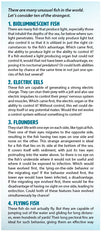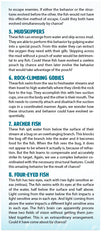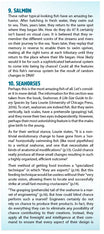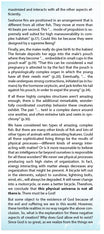Ten of the Strangest Fish in the World
Special-Order Folded Flyer Tract
 NOTE: This item is custom-printed to order (click for more details).
NOTE: This item is custom-printed to order (click for more details).
This tract is from our print-on-demand library, and is not kept in stock. Select the options below, and we will custom-print a batch just for you. Because this item is custom-printed, you can add your custom imprint to the back page at no extra cost.
- Estimated shipping date: Monday, February 2 (Click for more details)
- SKU:
- Discounts: Discount coupons do not apply to this item
- Format: Folded Flyer Tract
- Size: 3.66 inches x 8.5 inches
- Pages: 6
- Imprinting: Available with 5 lines of custom text
- Returns: Because this item is custom-printed to order, it cannot be returned.
Show all item details
The full text of this flyer tract is shown below. (Do you want to print this tract in a different version than the one listed? Contact us and let us know what you're looking for—we may be able to create the alternate version for you at no charge.)
There are many unusual fish in the world. Let’s consider ten of the strangest.
1. Bioluminescent fish
There are many fish that produce light, especially those that inhabit the depths of the sea, far below where sunlight penetrates. These fish not only produce light but also control it so that it is utilized in just the right circumstances to the fish’s advantage. Which came first, the ability to produce light or the ability to control it? If a fish evolved a light producing organ but could not control it, would that not have been a disadvantage, exposing it to nocturnal predators? Or could both abilities evolve by chance at the same time in not just one species of fish but several?
2. Electric eels
These fish are capable of generating a strong electric charge. They can stun their prey with a jolt and also use electric impulses to control their preys’ nervous system and muscles. Which came first, the electric organ or the ability to control it? Without control, this eel could destroy itself or any potential mates. Would the eel evolve a control system without something to control?
3. Flounders
They start life with one eye on each side, like typical fish. Then one of their eyes migrates to the opposite side, resulting in the fish having two eyes on one side and none on the other. This strange arrangement is ideal for a fish that lies on its side at the bottom of the sea. It covers itself with sediment, with just its two eyes protruding into the water above. So there is no eye on the fish’s underside where it would not be useful and where it could be exposed to infection. Which would have evolved first, the lying-on-the-side behavior or the migrating eye? If the behavior evolved first, the lower eye would have been infected, a disadvantage. If the migrating eye evolved first, there would be the disadvantage of having no sight on one side, leading to extinction. Could both of these features have evolved simultaneously by chance?
4. Flying fish
These fish do not actually fly. But they are capable of jumping out of the water and gliding for long distances, even hundreds of yards! Their long pectoral fins are ideal for such behavior, giving them an effective way to escape enemies. If either the behavior or the structures evolved before the other, the fish would not have this effective method of escape. Could they both have evolved simultaneously by chance?
5. Mudskippers
These fish can emerge from water and skip across mud. They are able to perform this behavior by gulping water into a special pouch. From this water they can extract the oxygen they need with their gills. Skipping across the mud without a pouch of water would be detrimental to any fish. Could these fish have evolved a useless pouch by chance and then later evolve the behavior that would take advantage of the pouch?
6. Rock-climbing gobies
These fish swim from the sea to freshwater streams and then travel to high waterfalls where they climb the rock face to the top. They accomplish this with two suction cups, one on the body and the other is their mouth. The fish needs to correctly attach and disattach the suction cups in a coordinated manner. Again, we wonder how these structures and behavior could have evolved sequentially.
7. Archer fish
These fish spit water from below the surface of their stream at a bug on an overhanging branch. This knocks the bug off the branch into the water and it becomes food for the fish. When the fish sees the bug, it does not appear to be where it actually is, because of refraction. But the fish learns to compensate and accurately strike its target. Again, we see a complex behavior coordinated with the necessary structural features. Could this amazing behavior be the result of chance?
8. Four-eyed fish
This fish has two eyes, each with two light sensitive areas (retinas). The fish swims with its eyes at the surface of the water, half below the surface and half above. Light coming from the water below the fish impacts a light sensitive area in each eye. And light coming from above the water impacts a different light sensitive area in each eye. The fish’s brain can apparently process these two fields of vision without getting them jumbled together. This is an extraordinary arrangement. Could it have come about by chance?
9. Salmon
These rather typical-looking fish have an amazing behavior. After hatching in fresh water, they swim out to sea. Then, years later, they return to the same spot where they began life. How do they do it? It certainly isn’t based on visual cues. It is believed that they remember the different scents of the streams and rivers on their journey to the sea. Years later, they replay that memory in reverse to enable them to swim upriver, making all the right turns at each tributary until they return to the place where their life began. How likely would it be for such a sophisticated behavioral system to come into being by chance? Could all the features of this fish’s nervous system be the result of random changes in DNA?
10. Seahorses
Perhaps this is the most amazing fish of all. Let’s consider it in more detail. The information for this section was taken from the book, Seahorses: A Life-Size Guide to Every Species by Sara Lourie (University of Chicago Press, 2016). To start, seahorses are indeed fish. But they swim vertically, lack scales, have a prehensile (grasping) tail, and they move their two eyes independently. However, perhaps their most astonishing feature is that the males give birth to the young.
As for their vertical stance, Lourie states, “It is a non-trivial evolutionary change to have gone from a ‘normal’ horizontally swimming fish (like most pipefishes) to a vertical seahorse, and one that necessitates all kinds of anatomical modifications” (p.13). Could chance really produce all these small changes resulting in such a highly organized, efficient outcome?
Their method of getting food involves a “specialized technique” in which “they are experts” (p.14). But this feeding technique would be useless without their “very acute vision, allowing them to locate and successfully strike at small fast-moving crustaceans” (p.14).
“The grasping (prehensile) tail of the seahorse is a marvel of engineering” (p.16). But how could blind chance perform such a marvel? Engineers certainly do not rely on chance to produce their products. In fact, they do everything they can to eliminate any possibility of chance contributing to their creations. Instead, they apply all the foresight and intelligence at their command to ensure that every aspect of their design is maximized and interacts with all the other aspects efficiently.
Seahorse fins are positioned in an arrangement that is different from all other fish. They move at more than 40 beats per second. This “… mode of propulsion is supremely well suited for high maneuverability in complex habitats” (p.17). Could this be because they were designed by a supreme Being?
Finally, yes, the males really do give birth to the babies! The female deposits her eggs into the male’s pouch where they become “… embedded in small cups in the pouch wall” (p.19). “That this can be considered a real pregnancy is attested to by the fact that the pouch is a physiologically complex organ in which the young have all their needs met” (p.20). Eventually, “… the male undergoes strong contractions, initiated (as in humans) by the hormone oxytocin, and jack-knifes his tail against his pouch, in order to expel the young” (p.34).
If all these highly complex structures aren’t amazing enough, there is the additional remarkable, wonderfully coordinated courtship behavior these creatures exhibit. The pair “… twirl in a complex dance around one another, and often entwine tails and swim in synchrony” (p.30).
We have considered ten types of amazing, complex fish. But there are many other kinds of fish and lots of other types of animals with astounding features. Could all these sophisticated living things be the results of physical processes—different kinds of energy interacting with matter? Or is it more reasonable to believe that an intelligence far beyond ourselves is responsible for all these wonders? We never see physical processes producing such high states of organization. In fact, energy interacting with matter always decreases any organization that might be present. A bicycle left out in the elements, subject to sunshine, lightning bolts, wind, etc., will always be degraded. It will never change into a motorcycle, or even a better bicycle. Therefore, we conclude that this physical universe is not all there is. There must be a God!
But some object to the existence of God because of the evil and suffering we see in this world. However, these terrible realities in no way negate the above conclusion. So, what is the explanation for these negative aspects of creation? Why does God allow evil to exist? Since God is so great, as we realize from the things we see, it is reasonable to believe that He is superior to us in all ways. So, there must be an explanation for the existence of evil and suffering.
If we have a sense of justice, then God is even more just. And, if we can love our children, then God must love us even more. So, since we do not always see justice and love prevail in this world, we conclude that this life is not all there is. There will come a day when God will judge us to see who is fit to inhabit a new and better world, where justice and love will prevail.
The question now arises—what must we do in order to enter that better world? In the Bible, God tells us that we must repent because He will judge the world in righteousness (Acts 17:30-31). To repent means to turn to God and to seek to do His will in all things. For those who repent, God has graciously provided a way that we may receive forgiveness for all the wrong doings of our past. This way is Jesus Christ. He died for all our wrong doings and rose again from the dead, conquering death itself. Through repentance and faith in Jesus Christ’s sacrifice for our sins, we can be forgiven and therefore be assured that we will be in that better world to come in which there will be no death nor any evil or suffering.
If it is your desire to repent, just tell God that is your intention and ask Him to help you live a life in accordance with His will. Then read the Bible to learn how God wants us to live—which is especially expressed in the New Testament. But, if you are really serious about doing God’s will, you will find that this is not always easy. Others will seek to influence you away from that. And even our own selfish inclinations are contrary to doing God’s will. To get extra help, you should get involved with others who are also seeking to do God’s will. There are millions of such people all over the world. You can find them in Christian churches where the Bible is believed. Pray and ask God to direct you into such a church. You might want to use the internet to look up Bible-believing churches in your area.













